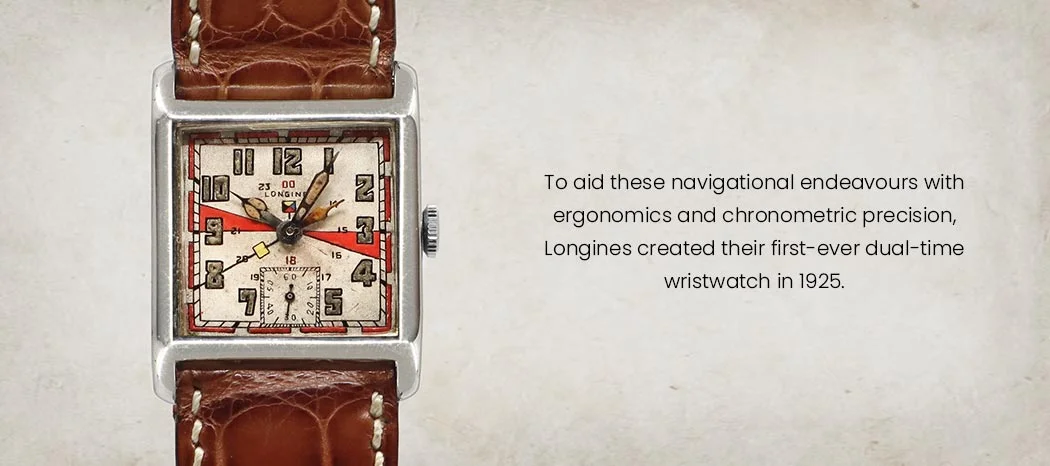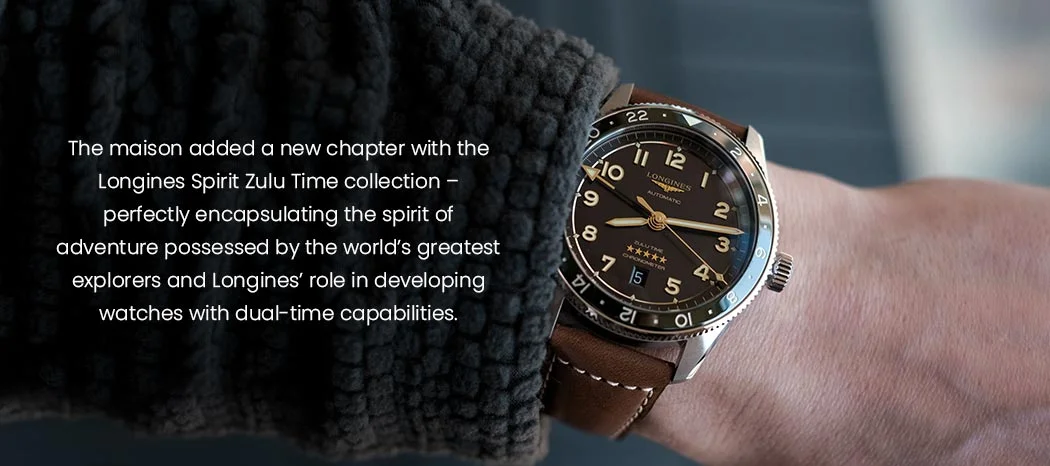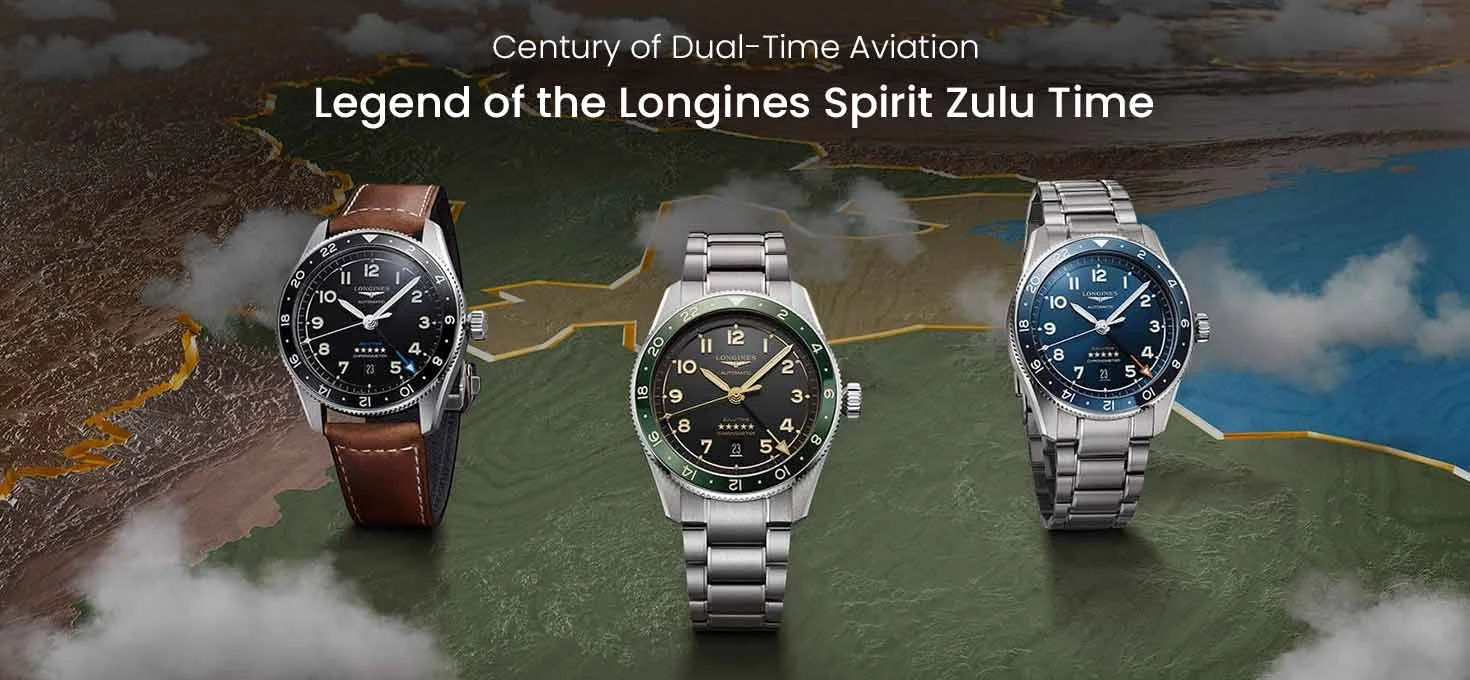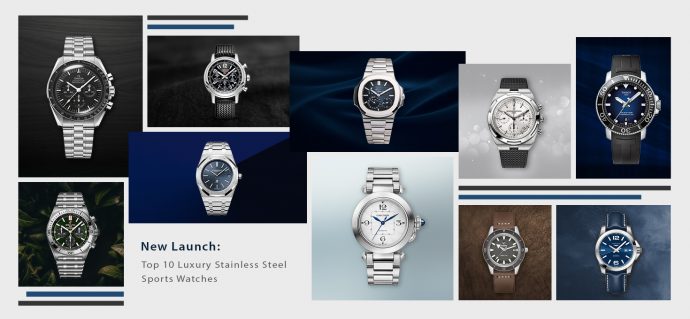How Time Flies
Longines’ logo is a winged hourglass – an ode to their double-century-long legacy of avigation chronometry and precision timekeeping in various sporting events. During its latter half, globalisation and military warfare pushed civilization to become airborne. Longines, as a watchmaker was perhaps the greatest technological contributor to the era’s innovation. Amidst freezing winds, deafening engine growls, and laden with fatigue, many daring navigators relied on their Longines chronometers to complete their journey.

At the cusp of the 20th century, aviators and sailors rampantly traversed across the Atlantic into foreign horizons and stranger tides, and tracking multiple time zones was critical for accurate navigation. To aid these navigational endeavours with ergonomics and chronometric precision, Longines created their first-ever dual-time wristwatch in 1925. The compact square timepiece bore an additional hour hand and ‘Zulu’ flag – ( In military and maritime lexicons, Zulu or ‘Z’ signifies Universal Time (UTC) – hence inspiring the timepiece’s title.. A century since its innovation, the modern-day Longines Spirit Zulu Time continues its dual-time legacy into tomorrow.
Longines’ History of Aviation Pioneers
Longines, as a maison, is a living laboratory and a silent witness of aviation’s greatest triumphs, supporting the 20th century’s most daring aviator endeavours and setting records of human exploration.
In 1927, Charles Lindbergh conquered the Atlantic solo, flying 33 and a half hours from New York to Paris, which led to his involvement in developing Longines’ Hour Angle Watch for celestial navigation. Five years later, the famed Amelia Earhart became the first solo woman to cross the Atlantic – completing her journey from Canada to Northern Ireland in just under 15 hours, guided by Longines’ unwavering precision.
Hollywood tycoon and aerospace engineer, Howard Hughes took a trip around the world in 1938, completing a full lap in just three days and 19 hours – aided by Longines’ precision. Elinor Smith, the youngest American aviator to become a licenced pilot at age 15 wore a Longines while piloting her aircraft to 27,418 feet – setting a world record. U.S. Navy officer, Philip Van Horn Weems co-designed the eponymous Weems Second-Setting Watch with Longines for aviators, allowing them to synchronize the timepiece’s seconds hand with a radio signal.
From Swiss Meadows to Open Skies
Long before Longines took to the skies, the maison was engaged in developing devices that accurately indicated the fifth, tenth, hundredth up to the millionth of a second.
This began with 1878’s calibre 20H – Longines’ first in-house movement mounted on jockeys’ mount and fitted in traditional stopwatches in American equestrian sports Longines developed a penchant in producing stopwatches, and three decades later, created one for Constantinople (present-day Istanbul), which converted Turkish time to Western time. As WWI loomed in, Longines created the world’s first wrist chronograph for Russian pilots and focused on refining its silhouette for ergonomics. This led to 1913’s super-compact chronograph wristwatch measuring 29 millimetres, Amelia Earhart wore a prototype of this model during her two Atlantic crossings in ’28 and ’32.
The Zulu – First Dual-Time Zone Watch

Quarter century before commercial aviation and GMTs became global obsessions, Longines took the mechanism off the WWI cockpit dashboard, developed a compact pocket-watch, and miniaturized further it for wrist-wear. The ‘Zulu’ timepiece was Longines’ first-ever dual-time wristwatch, introduced in 1925. It bore a ‘Zulu’ flag and a separate hour hand to indicate Coordinated Universal Time (UTC). The title, ‘Zulu’ or ‘Z’ is a UTC reference, commonly used by aviators, naval, and armed forces. The square-shaped, stainless-steel timepiece was used by radio operators on ships to convert local time to UTC. Notice those two red wedges? They indicated periods of radio silence reserved for emergency calls.
Longines Spirit Zulu Time – Same Trajectory, New Era

Almost a century since the original innovation, Longines unveiled the Spirit collection in early summer of 2020, embracing their aeronautical roots and channelling vintage design with modern sensibilities. Two years later, the maison added a new chapter with the Longines Spirit Zulu Time collection – perfectly encapsulating the spirit of adventure possessed by the world’s greatest explorers and Longines’ role in developing watches with dual-time capabilities.
The ’Zulu Time’ is powered by an exclusive in-house calibre employing a silicon balance-spring which drives the second time zone indicator. Offering a 72-hour power reserve, the movement is COSC chronometer-certified (Swiss Official Chronometer Testing Institute) signified by the five stars stamped on the dial. It also allows the GMT hand to be adjusted independently clubbed with a 24-hour, bidirectional bezel. On the dial, we see Arabic pilot indexes coated in Super- LumiNova® while the GMT hand’s tip is dipped in a contrasting hue. All this is strapped in stainless steel or leather with a refined adjustment system and cased in 42 millimetres of stainless steel.
Longines Spirit Zulu Time at Kapoor Watch Company
Embracing the centennial anniversary of Longines’ first dual-time wristwatch from 1925, the Spirit collection’s ‘Zulu Time’ is available at Kapoor Watch Company in a multitude of alter-egos. Ranging in case size options of 39 and 42 millimetres, the Zulu Time is primarily cast in brushed or polished Stainless Steel with an occasional Yellow Gold or Ceramic bezel. In terms of dial options, you may choose from black, grey, anthracite or blue, featuring a matte or sunray finish. With the signature fourth hand (24-hour second time zone hand) dipped in a striking red, blue, or yellow paint to contrast against the dial, we see five stars representing its high-quality craftsmanship and a date window at six o’clock. Strap options are subject to case material: Stainless Steel, leather, or NATO.
If you’re looking for something exceptional, the brand-new Zulu Time Titanium (Ref. L3.802.1.53.6) will not disappoint – featuring a 39-millimetre titanium case and ceramic bezel against a matte black dial, running automatic. For those with naval or nautical passions, the Ref L3.802.4.93.6 with an oceanic blue dial and 39-millimete Stainless Steel case would be perfect.





Recent Posts
Recent Comments
Archives